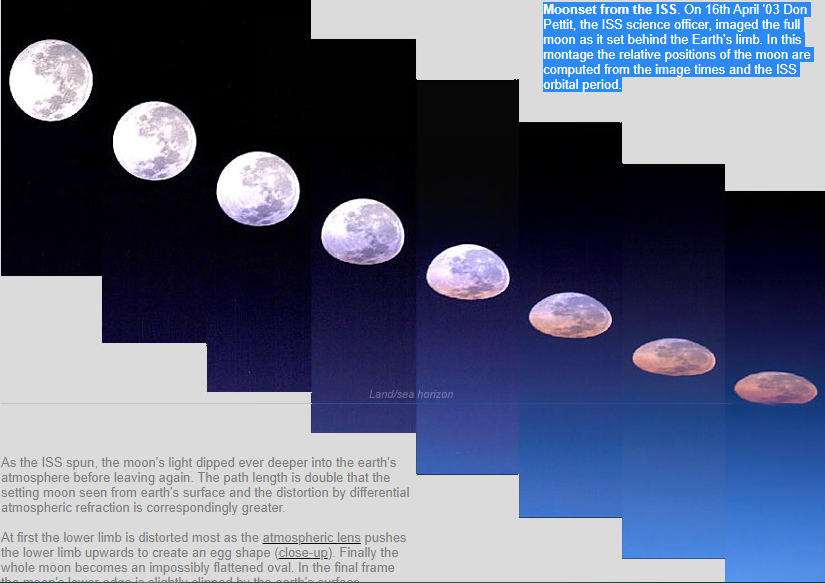Moonset from Earth Orbit
Moonset from Earth Orbit: A Spectacular View
Moonset from Earth orbit is a truly awe-inspiring sight that offers a unique perspective on our celestial neighbor. On April 16th, 2003, Don Pettit, the science officer aboard the International Space Station (ISS), captured a series of images as the full moon set behind the Earth's limb. This montage provides a mesmerizing glimpse into the relative positions of the moon as computed from the image times and the ISS orbital period.
As the ISS spun, the moon's light gradually descended deeper into the Earth's atmosphere before disappearing from view. The path length traversed by the moon during its descent is twice that seen from the Earth's surface, resulting in a more pronounced distortion caused by differential atmospheric refraction.
The lower limb of the moon experiences the greatest distortion initially, as the atmospheric lens pushes it upwards, creating an intriguing egg-shaped appearance when viewed up close. As the moon continues its descent, it undergoes a transformation into an impossibly flattened oval shape. In the final frame captured by Pettit, the moon's lower edge is slightly clipped by the Earth's surface, adding to the uniqueness of this celestial event.
One fascinating aspect of moonset from Earth orbit is the noticeable reddening of the lower part of the moon's disk and eventually its entire surface. This reddening is a result of preferential atmospheric scattering, which selectively scatters blue light out of the ray path. As a result, the remaining light that reaches our eyes consists mainly of longer-wavelength colors such as red and orange, giving the moon a distinct hue during its descent.
To witness such a captivating phenomenon requires being at the right place at the right time. The International Space Station's orbit provides a vantage point that allows astronauts to observe and document extraordinary events like moonset from Earth orbit. These images not only serve as breathtaking visual records but also contribute to our scientific understanding of atmospheric optics and the interplay between light and the Earth's atmosphere.
In addition to the visual spectacle, studying moonset from Earth orbit yields valuable insights into atmospheric refraction and the behavior of light as it interacts with the various layers of our atmosphere. The increased path length traveled by the moon's light during its descent amplifies the effects of differential atmospheric refraction, showcasing the remarkable ability of the atmosphere to bend and distort light.
As we continue to explore and study our planet and its surrounding celestial bodies, phenomena like moonset from Earth orbit offer a unique perspective that expands our understanding of the natural world. The images captured by Don Pettit aboard the ISS serve as a testament to the beauty and complexity of atmospheric optics, reminding us of the intricate interplay between light, atmosphere, and celestial bodies.
In conclusion, moonset from Earth orbit is a captivating event that reveals the moon in a whole new light. The distortion caused by differential atmospheric refraction, the reddening of the moon's surface, and the unique perspectives captured by astronauts aboard the International Space Station all contribute to our understanding of atmospheric optics. These observations remind us of the vastness and wonder of our universe, inviting us to explore and appreciate the mysteries that lie beyond our planet's boundaries.
Moonset from the ISS. On 16th April '03 Don Pettit, the ISS science officer, imaged the full moon as it set behind the Earth's limb. In this montage the relative positions of the moon are computed from the image times and the ISS orbital period.

As the ISS spun, the moon's light dipped ever deeper into the earth's atmosphere before leaving again. The path length is double that the setting moon seen from earth's surface and the distortion by differential atmospheric refraction is correspondingly greater.
At first the lower limb is distorted most as the atmospheric lens pushes the lower limb upwards to create an egg shape (close-up). Finally the whole moon becomes an impossibly flattened oval. In the final frame the moon's lower edge is slightly clipped by the earth's surface.
The lower part of the disk and then the entire moon is appreciably reddened by preferential atmospheric scattering of blue light out of the ray path.
Individual images NASA/JPL: composite ©Les Cowley
Note: this article has been automatically converted from the old site and may not appear as intended. You can find the original article here.
Reference Atmospheric Optics
If you use any of the definitions, information, or data presented on Atmospheric Optics, please copy the link or reference below to properly credit us as the reference source. Thank you!
-
<a href="https://atoptics.co.uk/blog/moonset-from-earth-orbit/">Moonset from Earth Orbit</a>
-
"Moonset from Earth Orbit". Atmospheric Optics. Accessed on April 27, 2024. https://atoptics.co.uk/blog/moonset-from-earth-orbit/.
-
"Moonset from Earth Orbit". Atmospheric Optics, https://atoptics.co.uk/blog/moonset-from-earth-orbit/. Accessed 27 April, 2024
-
Moonset from Earth Orbit. Atmospheric Optics. Retrieved from https://atoptics.co.uk/blog/moonset-from-earth-orbit/.